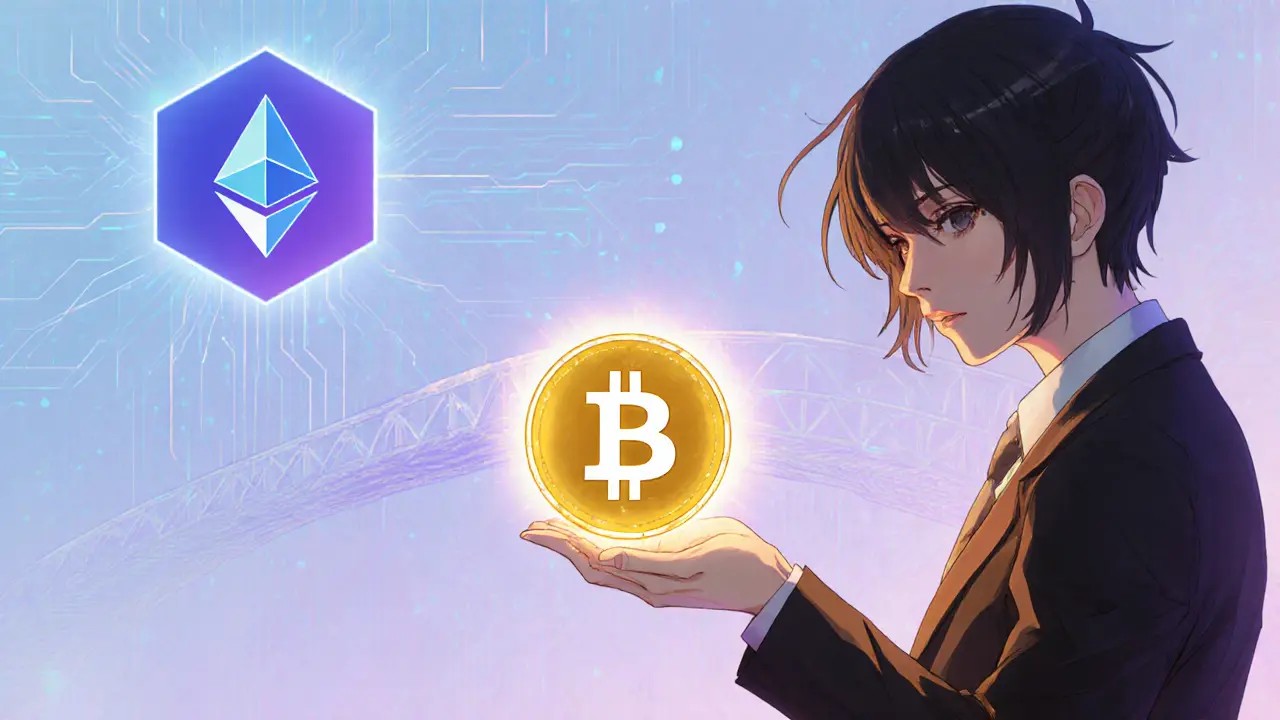WRBTC Gas Fee Estimator
Calculate WRBTC Transaction Costs
Estimate Ethereum gas fees for wrapping or unwrapping WRBTC tokens based on current network conditions.
The token WRBTC is an ERC‑20 representation of Rootstock Bitcoin (RBTC) on the Ethereum blockchain, letting Bitcoin‑backed value flow into Ethereum’s DeFi world.
What Wrapped Rootstock Bitcoin Actually Is
Wrapped Rootstock Bitcoin (WRBTC) is an ERC‑20 token that mirrors the value of RBTC, which itself is 1:1 pegged to Bitcoin (BTC). The token lives on Ethereum (chain ID 1) but is backed by the security of Bitcoin’s proof‑of‑work through the Rootstock sidechain.
How the Two‑Layer Wrapping Works
Rootstock’s native coin, Rootstock Bitcoin (RBTC) acts as ‘programmable Bitcoin’ secured by merged‑mined Bitcoin miners, is first minted on the Rootstock network (chain ID 30). When a user deposits RBTC into the Rootstock‑Ethereum bridge, a smart contract on Ethereum automatically mints an equivalent amount of WRBTC. The reverse process burns WRBTC and releases the original RBTC.
This dual‑wrap uses the PowPeg a trust‑minimized two‑way peg that relies on Bitcoin miners rather than custodial services. Unlike the centralized model used by Wrapped Bitcoin (WBTC) which depends on BitGo’s custodial infrastructure, PowPeg’s federation of 50+ independent nodes validates cross‑chain moves, keeping the system decentralized.
Technical Specs You Should Know
- Contract address on Ethereum:
0x542fda317318ebf1d3deaf76e0b632741a7e677d(verified on Etherscan). - Standard ERC‑20 functions:
transfer,approve,transferFrom. - Total supply adjusts dynamically based on RBTC locked in the bridge.
- Bridge fees: ~0.02 USD in average Ethereum gas; spikes to ~0.50 USD during congestion.
- Bridge confirmation time: 15 min - 2 h depending on Bitcoin block confirmations.
To interact you need an Ethereum‑compatible wallet (MetaMask v10.14.1+ is recommended) with both the Ethereum network and the Rootstock network added via RPC https://public-node.rsk.co/, ChainID 30, Symbol RBTC.
WRBTC vs. WBTC: A Quick Comparison
| Feature | WRBTC | WBTC |
|---|---|---|
| Underlying asset | RBTC (itself 1:1 to BTC) | Direct BTC |
| Bridge model | PowPeg - decentralized federation | BitGo custodial escrow |
| Decentralization rating | High (miners + 50+ nodes) | Medium (central custodian) |
| Liquidity (Oct 2023) | ~$87 M TVL | ~$4.8 B TVL |
| Typical gas cost | ~$0.02 (normal) - $0.50 (peak) | ~$0.03 (normal) - $0.70 (peak) |
Use Cases: Why Holders Choose WRBTC
Because WRBTC inherits Bitcoin’s proof‑of‑work security while being ERC‑20 compatible, it shines in a few niches:
- DeFi yield farming on Ethereum protocols without trusting a centralized custodian.
- Providing collateral in Rootstock‑based projects such as Money on Chain’s RIF ecosystem.
- Cross‑chain arbitrage between Rootstock, Ethereum, and other EVM chains (though native bridges to BNB Chain or Polygon are still missing).
Conversely, if you need instant liquidity or plan to trade on many centralized exchanges, WBTC remains the more practical choice.

Risks and Considerations
Security analysts note a few red flags:
- The federation node architecture has a "moderate risk" rating - a severe network partition could temporarily freeze funds (Trail of Bits, 2022).
- Liquidity is modest; large swaps may cause noticeable price impact.
- Bridge transactions depend on both Ethereum and Bitcoin confirmations, so delays of up to two hours are possible.
Despite these, the decentralized nature means WRBTC is less likely to be classified as a security under current SEC guidance, a benefit that WBTC lacks.
Getting Started: Step‑by‑Step Guide
- Install MetaMask or another ERC‑20‑compatible wallet.
- Add the Rootstock network:
- Network name: Rootstock Mainnet
- RPC URL:
https://public-node.rsk.co/ - Chain ID: 30
- Symbol: RBTC
- Obtain RBTC on the Rootstock network (via a supported exchange or direct swap).
- Go to the official bridge UI (link provided by RSK Labs).
- Send the desired RBTC amount to the bridge address; confirm the transaction in MetaMask.
- After the bridge confirms, WRBTC will appear in your Ethereum wallet. You can now supply it to DeFi protocols.
- To unwrap, send WRBTC to the bridge’s burn address; the corresponding RBTC will be released back to your Rootstock address.
Remember to keep a small ETH balance for gas fees on every step.
Market Snapshot & Outlook (2025)
As of October 2023, WRBTC held a market cap of roughly $287 M and ranked #95 on CoinGecko. Messari projects a 22 % annual growth through 2026, driven by increasing demand for trust‑minimized Bitcoin‑DeFi exposure. Recent developments include a partnership with Chainlink to provide decentralized price feeds for WRBTC and a Layer‑2 pilot aiming to cut Ethereum gas by 70 % (expected Q4 2023 rollout).
However, analysts caution that Ethereum scalability upgrades (e.g., sharding) could reduce the need for wrapped Bitcoin assets altogether. Keep an eye on the Rootstock roadmap for native Layer‑2 solutions that might further align WRBTC with Ethereum’s evolving ecosystem.
What is the difference between WRBTC and RBTC?
RBTC is the native token of the Rootstock sidechain, directly pegged 1:1 to Bitcoin. WRBTC is an ERC‑20 wrapper of RBTC that lives on Ethereum, enabling ERC‑20 interactions while still representing Bitcoin’s value.
How secure is the WRBTC bridge?
The bridge uses the PowPeg mechanism, which relies on Bitcoin miners for security and a federation of 50+ independent nodes for transaction validation. While audits label the design as "moderate risk" for rare network partitions, no successful exploits have been reported to date.
Can I use WRBTC on non‑Ethereum chains?
Currently WRBTC is only bridged between Rootstock and Ethereum. There are no native bridges to BNB Chain, Polygon, or other EVM chains, though third‑party cross‑chain protocols are experimenting with indirect routes.
What are typical fees for wrapping and unwrapping?
Gas fees on Ethereum average $0.02 under normal conditions and can rise to $0.50 during congestion. The bridge itself does not charge extra fees, but you need to pay Bitcoin transaction fees for the underlying RBTC movement.
Is WRBTC a good choice for yield farming?
If you want Bitcoin‑backed exposure to Ethereum DeFi without trusting a centralized custodian, WRBTC is a solid option. Expect lower TVL and slightly higher slippage than WBTC, but you gain stronger decentralization guarantees.


Post Comments (3)
Wrapped Rootstock Bitcoin feels like a philosophical bridge between the old guard of proof‑of‑work and the shiny world of DeFi. Yet I can’t shake the feeling that every layer we add is a hidden trap set by the powers that be. The whole PowPeg system sounds great until you realize the miners could decide to freeze everything. We should stay vigilant.
Sure, the idea sounds noble, but history shows that “decentralized” often just means “invisible control”. Maybe the bridge will work, maybe it won’t-time will tell, I suppose.
I appreciate the cautious perspective offered herein. It is essential, when evaluating novel cross‑chain mechanisms, to consider both the cryptographic guarantees and the governance structures underpinning the federation. While the PowPeg architecture ostensibly mitigates custodial risk, the moderate risk rating assigned by auditors warrants thorough due‑diligence prior to capital allocation.